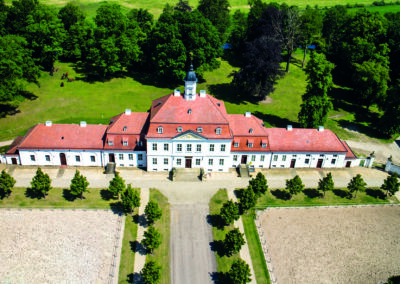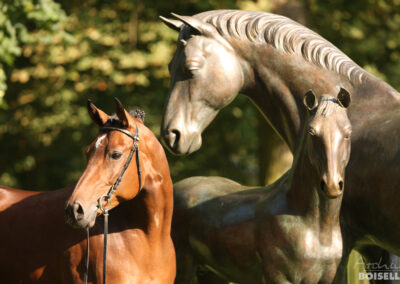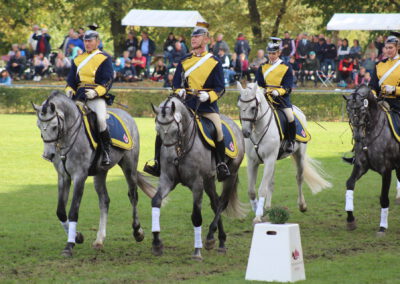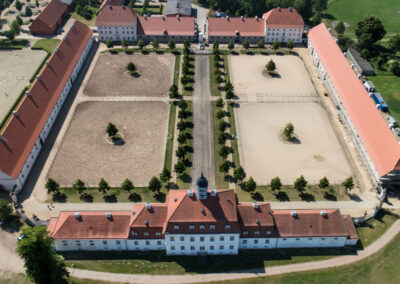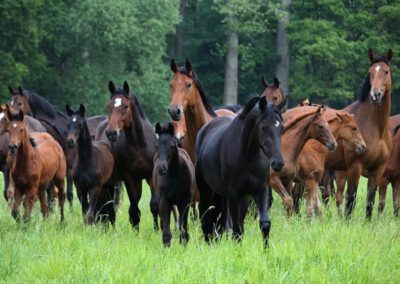Neustadt-Dosse State Stud
Germany
The Neustadt studs, located in Brandenburg not far from Berlin, can look back on over 220 years of tradition in horse breeding and training. The history of the studs has always been an eventful one, always closely interwoven with the history of the state.
Neustadt is one of the few locations that is home to a main stud (mares) in addition to the traditional state stud (stallions). 40 elite and state premium mares form the breeding basis of the Brandenburg Main and State Stud. The following horse breeds are represented in the studs: German Sport Horse, English Thoroughbred, Trakehner, Coldblood, Haflinger, Riding Pony.
The attractive stud farms are located on a spacious area of approx. 400 hectares with many paddocks and avenues.The two classicist stud farms provide ideal breeding facilities. As protection against privatization, the Neustadt studs have been a foundation under public law since 2001.
Neustadt (Dosse) State Stud
Hauptgestüt 10
16845 Neustadt (Dosse)
Deutschland
www.neustaedter-gestuete.de
E-Mail: info@neustaedter-gestuete.de
The story
Frederick William II (reigned 1786 – 1794) loved everything beautiful, including fine horses, which he could not find in Prussia. His young traveling adjutant Carl Graf von Lindenau, a cavalry officer and son of a Saxon chief stable master, inspired the king with the idea of establishing stud farms in order to cultivate the hitherto unattractive local horse breeding with first-class stallions.The “Landemanne” was to have selected stallions at his disposal to breed noble horses.Frederick William II therefore instructed Count Carl Heinrich August von Lindenau to reorganize the Prussian stud system.
On July 31, 1787, the king signed the corresponding law “For the good of the country”. Just under a year later, on March 26, 1788, the Prussian War and Domain Council decreed that a breeding facility named “Friedrich-Wilhelm” was to be built on the site of the mule stud.600 acres of land were transferred to the Oberstallamt for meadows and pastures.Shortly afterwards, the Saxon building inspector Glasewald began to build today’s main stud farm for around 60 broodmares and, one kilometer away, the Kurmärkisches Landgestüt, known as Lindenau-Hof (today the state stud farm) for around 100 stallions.
Both facilities were built as rectangular courtyards in the classicist architectural style.
Tasks
The State of Brandenburg is committed to developing the Brandenburg Main and State Stud Farm into a center of sustainable rural development of regional and supra-regional importance.Rural development in the sense of the strategic approach of the European Union means making rural areas tangible (“touching”) with concrete projects that are tangible for citizens and at the same time lead to economic value creation in the supported region.The high cultural and historical significance of this stud farm, one of the largest in Germany, and the stud’s reputation for breeding provide an excellent framework for this.
The tasks of the stud are therefore:
- Rural development
- Economic independence
- Preservation and maintenance of the listed facility
- Provision of well-bred stallions
- Preservation of the local horse breeds
Four areas of competence (hippological area, marketing & regional development, administration/controlling, property management) carry out these tasks.
Stud areas (hippological area of competence)
One of the sovereign tasks of the Main and State Stud is to provide high-quality, performance-tested stallions.The stallions should primarily be available to breeders in Berlin-Brandenburg and Saxony-Anhalt at moderate stud fees. In the period from March 1 to July 15 of each year, a network of 15 to 20 stallion stations in the states of Berlin-Brandenburg and northern Saxony-Anhalt is used. In two stations (Neustadt, Krumke), which are also recognized by the European Union, the stallions’ semen is distributed throughout Europe via artificial insemination.
Another sovereign task is the performance testing of stallions and mares. This is carried out on the basis of the Federal Ordinance on Performance Testing and the Determination of Breeding Values for Horses and the Animal Breeding Act. Stallion performance tests have been carried out since 1978 at the testing facility in Neustadt (Dosse), which is predestined for this purpose.This institution is one of the most frequented testing facilities in Germany.
The riding and driving school is the ideal training center for all participants to receive qualified instruction in riding, driving or handling horses.The traditional training center is recognized by the German Equestrian Federation (FN) as a specialist school for riding and driving training. The focus is on the training of amateur instructors for riding and driving, which concludes with the certificate of a specialist instructor, amateur riding instructor or amateur driving instructor.
The driving center of the Brandenburg Main and State Stud offers training and advanced training for driving horses and drivers as well as the training and correction of driving horses by head saddle master Rainer Stübing.It is also possible to purchase and broker driving horses at any time.
For years, the vocational training program for horse management with a focus on “breeding and husbandry” in Neustadt (Dosse) has enjoyed growing popularity.Over 200 applications are processed every year, of which unfortunately only five to seven can be considered for the three-year apprenticeship.
The “Riding at school” project is unique in Germany and is carried out with the Neustadt comprehensive school with a grammar school.Riding is a subject that is relevant for promotion up to the Abitur and is currently attended by around 175 pupils. Riding can be chosen as a compulsory elective subject, for which no previous riding experience is required.In a special class, particularly talented pupils are supported according to their talents.
Many events are held every year for both the professional public and horse enthusiasts. In addition, the stud site with its newly renovated buildings is ideal for hosting events of all kinds.


